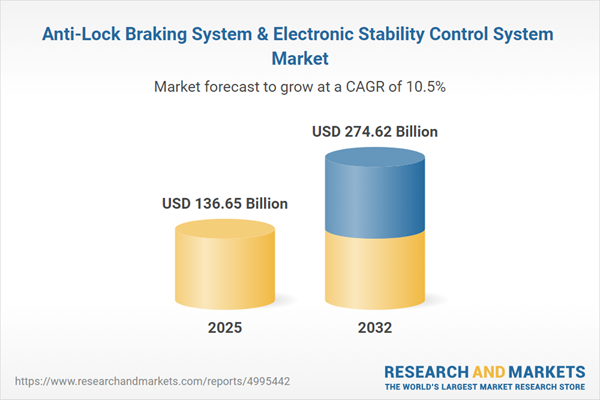Speak directly to the analyst to clarify any post sales queries you may have.
Senior automotive leaders are navigating an inflection point in vehicle safety as anti-lock braking system and electronic stability control technologies reshape mobility expectations worldwide. With regulatory requirements and digital transformation converging, these systems are critical for next-generation road safety and compliance strategies.
Market Snapshot: Anti-Lock Braking System & Electronic Stability Control System Market
The global anti-lock braking system and electronic stability control system market is demonstrating robust expansion, forecasted to climb from USD 123.38 billion in 2024 to USD 136.65 billion in 2025. This upward momentum is set to continue through 2032 with a forecast CAGR of 10.51%, elevating the market to USD 274.62 billion. Heightened regulatory scrutiny, increased consumer focus on advanced safety, and integration of new electrified vehicle platforms are the primary forces accelerating demand. Digitalization and vehicle electrification are also advancing the adoption of modular, high-performance solutions across established and emerging automotive markets.
Scope & Segmentation
- Sales Channels: Coverage includes both aftermarket options and direct OEM integration, supporting diverse procurement strategies and long-term lifecycle management.
- Vehicle Types: Segments encompass heavy commercial vehicles, light commercial vehicles, and passenger cars, including compact, luxury, and midsize classes.
- System Types: The market addresses anti-lock braking modules, electronic stability control (ESC), and variants such as rollover mitigation and traction control, aligned with evolving safety standards.
- Propulsion Methods: Analysis spans electric, hybrid, and internal combustion platforms, including battery electric vehicles, fuel cell electric vehicles, and hybrid propulsion mechanisms.
- Channel Counts: Configurations available in eight, four, and two-channel setups, enabling tailored safety and control solutions for complex vehicle requirements.
- Regions Covered: The research encompasses Americas (North and Latin America), Europe (covering major and emerging economies), Middle East (key industrial and growth centers), Africa (core automotive markets), and Asia-Pacific (regional leaders in mobility innovation).
- Key Companies Profiled: Analysis includes Robert Bosch GmbH, Continental AG, ZF Friedrichshafen AG, Aisin Seiki Co., Ltd., Hyundai Mobis Co., Ltd., Hitachi Astemo, Ltd., Mando Corporation, Nissin Kogyo Co., Ltd., Aptiv PLC, and Knorr-Bremse AG, reflecting the landscape of both established and innovative suppliers.
Key Takeaways for Decision Makers
- Safety systems have transitioned from discretionary features to core differentiators, influencing both OEM strategies and consumer purchasing decisions in all vehicle categories.
- Compliance with global and regional regulations is driving broad deployment of advanced braking and dynamic control technologies, necessitating ongoing investment in R&D and certification.
- The move toward electrified and autonomous vehicle architectures amplifies the importance of precision braking and stability, directly impacting safety and operational efficiency.
- Collaboration between established component manufacturers and software partners is accelerating the rollout of modular solutions, supporting scalable adoption across varied global vehicle platforms.
- Rapid market developments, such as electrification trends in Asia Pacific and the evolution of safety certification in Europe, underscore the importance of tailored, region-specific product strategies and agile supply chains.
Tariff Impact and Supply Chain Adaptations
Recent tariff measures applied from 2025 have required suppliers and OEMs to reassess sourcing and production strategies. To mitigate the risks associated with trade fluctuations and supply chain disruptions, organizations are implementing nearshoring initiatives and shifting toward product standardization and modular design. These adaptations support consistent delivery, cost efficiency, and compliance amid evolving regulatory landscapes while enabling strategic localization of essential manufacturing operations.
Methodology & Data Sources
This market report utilizes a multi-source research methodology centered around direct interviews with industry executives. Findings are substantiated with a detailed review of technical documents and policy literature. Data is cross-validated through triangulation and expert panels, reinforcing the accuracy and insight of the market analysis.
Why This Report Matters
- Senior leaders and strategists can benchmark sector growth, technology shifts, and policy developments to inform investment prioritization.
- Comprehensive segmentation analysis highlights actionable opportunities by channel, vehicle class, system configuration, and geographic market, supporting targeted business development.
- The report offers perspectives on how evolving trade regulations impact supplier dynamics, pricing thresholds, and market positioning across regions.
Conclusion
The anti-lock braking system and electronic stability control sector is being defined by advancing technology, rising safety expectations, and a dynamic regulatory environment. Proactive alignment of innovation, supply chain management, and localized strategies will be instrumental in securing sustainable competitive advantage.
Additional Product Information:
- Purchase of this report includes 1 year online access with quarterly updates.
- This report can be updated on request. Please contact our Customer Experience team using the Ask a Question widget on our website.
Table of Contents
3. Executive Summary
4. Market Overview
7. Cumulative Impact of Artificial Intelligence 2025
List of Figures
Samples

LOADING...
Companies Mentioned
The key companies profiled in this Anti-Lock Braking System & Electronic Stability Control System market report include:- Robert Bosch GmbH
- Continental AG
- ZF Friedrichshafen AG
- Aisin Seiki Co., Ltd.
- Hyundai Mobis Co., Ltd.
- Hitachi Astemo, Ltd.
- Mando Corporation
- Nissin Kogyo Co., Ltd.
- Aptiv PLC
- Knorr-Bremse AG
Table Information
| Report Attribute | Details |
|---|---|
| No. of Pages | 199 |
| Published | October 2025 |
| Forecast Period | 2025 - 2032 |
| Estimated Market Value ( USD | $ 136.65 Billion |
| Forecasted Market Value ( USD | $ 274.62 Billion |
| Compound Annual Growth Rate | 10.5% |
| Regions Covered | Global |
| No. of Companies Mentioned | 10 |









